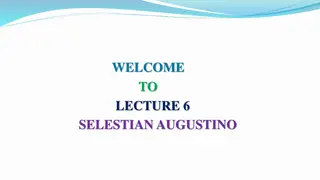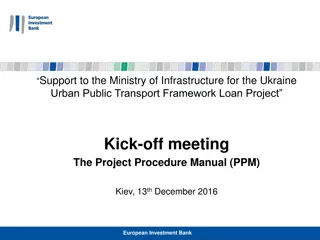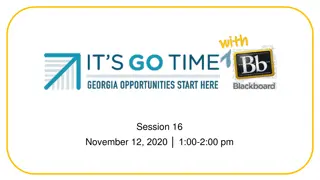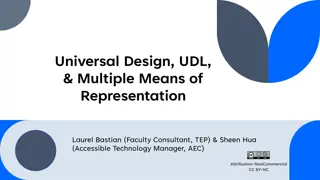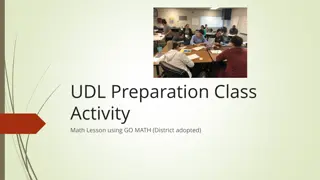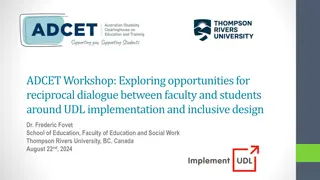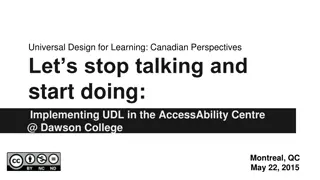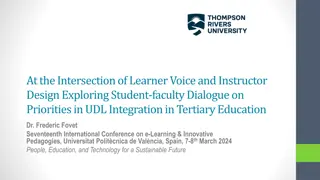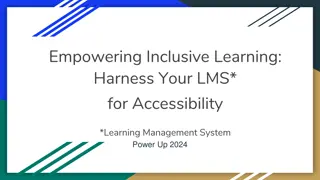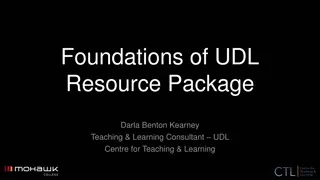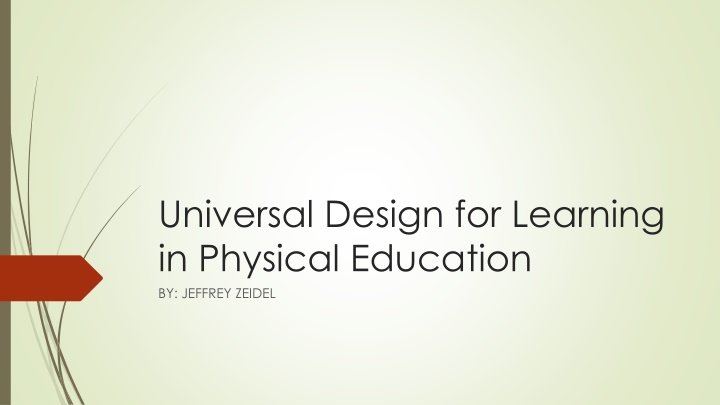
Implementing Universal Design for Learning in Physical Education
Explore the concept of Universal Design for Learning (UDL) and its application in physical education to enhance teaching and learning for all individuals. Discover the guidelines, challenges, original plans, and strategies for implementing UDL effectively in educational settings.
Download Presentation

Please find below an Image/Link to download the presentation.
The content on the website is provided AS IS for your information and personal use only. It may not be sold, licensed, or shared on other websites without obtaining consent from the author. If you encounter any issues during the download, it is possible that the publisher has removed the file from their server.
You are allowed to download the files provided on this website for personal or commercial use, subject to the condition that they are used lawfully. All files are the property of their respective owners.
The content on the website is provided AS IS for your information and personal use only. It may not be sold, licensed, or shared on other websites without obtaining consent from the author.
E N D
Presentation Transcript
Universal Design for Learning in Physical Education BY: JEFFREY ZEIDEL
What is Universal Design for Learning? "Universal design for learning (UDL) is a framework to improve and optimize teaching and learning for all people based on scientific insights into how humans learn" (CAST). https://www.youtube.com/watch?v=gmGgplQkrVw
What are the guidelines of UDL?
Part 1: What led me to UDL? As a student, I struggled within certain subjects to understand the key components and principles. I had to develop my own strategies that would enable me to overcome my barries. I learnt quickly when entering the field of education that students learn at different paces and learn in multiple ways. When reflecting on my methods of pedagogy I discovered that I was teaching students to my liking rather than teaching to theirs. It was only until my final year of my graduate degree that I discovered UDL through a peer presentation. Since learning the basics of UDL I have been trying to implement strategies to help ease student success.
The Problem: Source: https://www.jantakhoj.com/blog/bell-curved-performance-appraisals-good-bad/
Obstacles within Physical Education Student presence and participation Non- typical classroom Wide level of student experience/knowledge of course material/subject Student backgrounds Mobility issues Medical issues Limited time (30hrs over 15 weeks) Types of learners Assessment tools
Original Plan: Implementation of a full semester scaffolding project which would have included: Fitness and lifestyle assessment Dietary analysis Healthy meal presentation End of semester reflection Modified Plan Implementation of UDL tools and strategies into existing courses. Tools and strategies to be seen in upcoming slides
Part 2: Implementing Strategies and Techniques
Guiding Guidelines
Engagement Providing options for recruiting interest: Through the use of various applications and media platforms students were provided meaningful ways of drawing attention interests towards class activities and assignments. Ex: Physical Education Instagram Page Ex: Individualized Moodle class pages for each course Student autonomy was also seen as a critical means of recruiting interest. There was no point in forcing students into performing generalized assignments. Class assignments were adapted to be unique to each students interest of the course. Ex: Individualized program plans
Engagement Options for sustaining effort and persistence: Participation grades hold important value to every physical education class and the importance to have students engaged to maximize success is critical. Creating a warm and safe environment was a means in achieving this goal. Ex: No phone policy Increase student to student interactions Ex: Partner and group work in a controlled environment Ex: Low organized games that are silly and fun to bring out inner emotions Such activities allowed groups to create a sense of community within the classroom.
Engagement Options for self-regulation: Dawson is the largest English Cegep in Quebec, welcoming roughly 11,000 students. That is a 11,000 unique individuals that come from 11,000 unique backgrounds with each requiring a means of self-regulation. At the end of each class students are offered a variety of tools to self-regulate: Ex: Individualized active response sheets Ex: Meditation, stretching, yoga or active cooldown Ex: Personal feedback These tools may not meet each students need however the use of these tools such as weekly reflections appear to provide a gateway for students to regulate certain thoughts and feelings.
Representation Through the use of the UDL approach providing multiple means of representation is critical to students comprehension. Tools provided for perception: Simplified course outlines highlighting critical components of the course : Course Outline Example Weekly PowerPoints notes to culminate course package Example #1 Example #2 PowerPoints were uploaded prior to each class to allow students become familiar with weekly lessons to help encourage understanding and class participation.
Representation Similar to every discipline, Physical Education and Health industry uses a wide-range of language and symbols. The lingo can become complicated and will leave students playing catchup if not learnt. Through the use of cheat sheets and study guides, Students are provided with the tools to feel competent and comfortable within class. Examples of some documents used in class: Weight Training Terminology Progressions Movement Library
Representation My long-term goal for UDL is provide students with a flipped classroom. In the meantime, I have spent a majority of my time in providing students with recordings on key concepts and projects from class. This provides students who are absent to access missed content Provides students another representation or viewpoint to the topic at hand. Unlimited playbacks Examples: Example 1 Example 2
Action and Expression One of my main objectives of UDL was to provide multiple means of expression and actions for my students. There isn't one blueprint for all, students have their own unique strengths and weaknesses and should be able to choose their own path to the finish line. Physical Action: Assignments, students were provided with less structured assignments to encourage creativity. Example 1 Example 2 Example 3
Action and Expression I was never great when it came to linguistics, I always felt that assignments were often bias towards one's ability to articulate in the written word. This semester I provided students the option to express their work in various means. Most students kept to the traditional means of expressing their work however, I did have several students decide to present their work orally or visually. Results: Students from all various disciplines producing unique assignments through countless avenues: Mindmaps Prezi Video projects PowerPoint
Action and Expression Providing options for executive functions: With the winter 2020 semester moving to online I did my best to support students in various means for executive functions: Webinars (zoom) How to videos (youtube & moodle) Weekly planning sessions for students (individual and collaboratively) Weekly feedback related to goals
Outcome of a UDL approach A Universal Design for Learning approach has had Safer and more welcoming environment Understanding of course competency and elements Better understanding of course material and assignments Improved grades Improved accessibility digitally Decrease in student stress Data was collected through quick surveys, class discussion and 1 on1 conversations
What is next? My UDL journey is not yet over. I plan to focus my attention on improving my course assignments and activities. My long-term goal is to provide: Flipped classrooms with pre-recorded class lectures More "how to" videos explaining assignments and course materials Continue to build my Moodle pages Implementing more diverse and inclusive activities into class
Part 3: My learning Experience and Emotions
My learning Experience Implementing a UDL approach was a much bigger task than I originally thought. Through the experience I found myself immersing myself deeper within the College and extending my network to other departments and committees. Not only has the UDL approach helped my students, it has also led me to develop and improve my professional skills, such as: Adobe professional Wacom (tablet use) Moodle Film recording and editing
My learning Experience (cont) The following diagram illustrates the CAST UDL implementation process into schools & school boards. Source: http://www.cast.org/products-services/consultation-curriculum-design
My learning Experience (cont) Switching to a UDL left me feeling like a first year teacher again. Source: Moir, E. (1990). Phases of first-year teaching
Feedback to future UDLers Don t be afraid to try new things Take all the advice you can get At first if it doesn t work, don t give up. Trust the process!
References: Consultation & Curriculum Design (n.d). Retrieved from http://www.cast.org/products-services/consultation-curriculum-design Meyer, A., Rose, D. H., & Gordon, D. T. (2014). Universal design for learning: Theory and practice. Moir, E. (1990). Phases of first-year teaching. California New teacher Project Newsletter. Sacramento, CA: California Department of Education. Novak, K. (2016). Udl now!: A teacher's guide to applying universal design for learning in today's classrooms. Place of publication not identified: Cast Professional Pub.

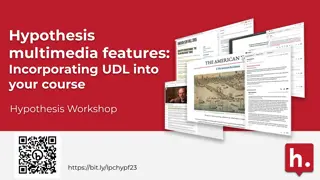


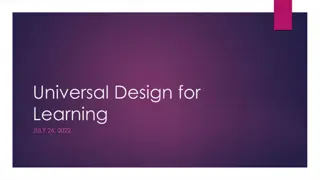
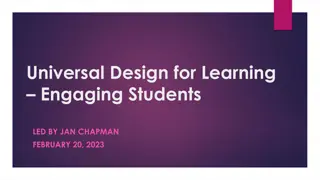
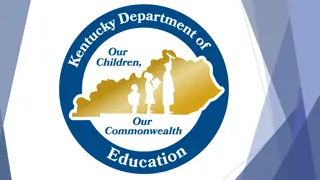
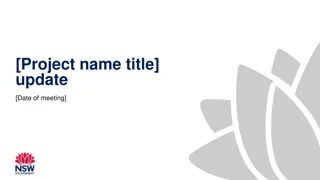

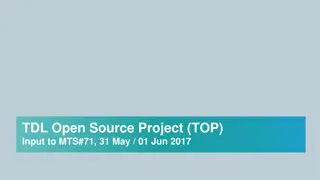

![Project Initiation Document for [Insert.Project.name] [Insert.Project.number]](/thumb/226757/project-initiation-document-for-insert-project-name-insert-project-number.jpg)
